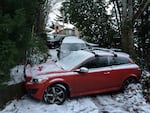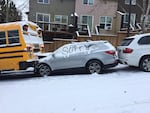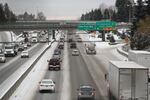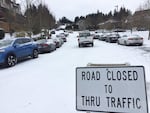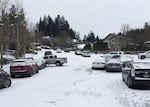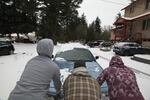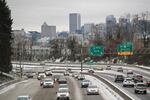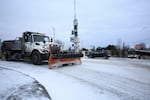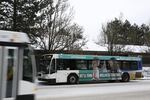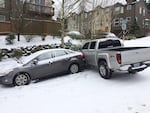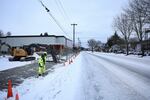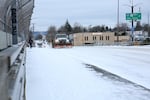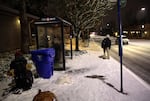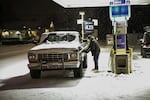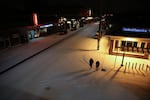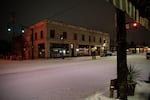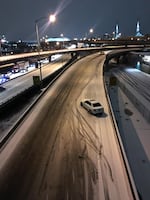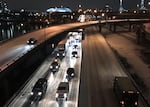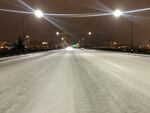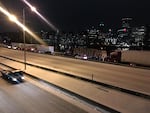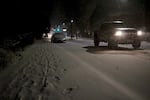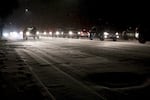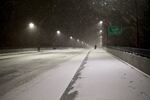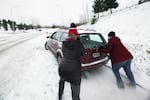
Friends help push Jacey Bustad's car out of a snow bank after it got stuck halfway up Mt. Scott Wednesday night.
Amelia Templeton / OPB
The city of Portland came to a sudden halt Wednesday afternoon as the perfect mix of snow, ice and a mass rush of commuters trying to beat the weather home created gridlock across the metro area.
Motorists were stranded — cars abandoned in some cases — and children were stuck at their schools or on school buses.
Don Hamilton, with the Oregon Department of Transportation says he hopes fewer drivers on the road Thursday will allow work crews to clear the ice.
"We’ve been putting sand out, we’ve been plowing, we’re trying to get this snow up. The best thing that can happen today and I think we’ll see this today, there will be fewer cars on the road," he told OPB's Geoff Norcross Thursday morning.
"Yesterday nothing was closed in the morning, it was so nice and dry, and all the schools were open and businesses were open. Today we’re going to see a lot of people staying home because schools and businesses are closed."
Related: More Cold Winter Weather In Store For Oregon
"So we’ll have fewer vehicles on the road, it’ll let us get in and try to get some of this packed snow up, maybe some sun will break through and help dry things out a little bit," Hamilton said.
The mix of heavy traffic and the timing of the snow led to the widespread gridlock, according to John Brady with the Portland Bureau of Transportation.
“The timing was awful. The forecast was for snow in the afternoon,” he said.
In preparation of that PBOT started putting de-icer down on main routes Tuesday and early Wednesday, but tens of thousands of commuters trying to leave the city at once and the snow hitting slightly earlier than expected rendered much of the prep work useless.
“People driving on the snow compacted it down and made the de-icer less effective," Brady said. “Nobody anticipated the level of gridlock we saw,” he said.
The city tried to reduce the number of cars on the road by extending parking amnesty Wednesday afternoon through Thursday at noon. But many drivers still tried to make it home in their vehicles. Some of those drivers, stuck in traffic or spun out on slick roads, eventually abandoned their cars on the side of — or even in the middle of busy roads and highways.
That's a big problem, according to Brady. The abandoned cars make it hard for emergency responders and PBOT’s crews to get through.
“Our message is, if you can get your cars and move them to a safe space off the main roads or off the road that would be great.”
“Again, my emphasis is on when it’s safe to do so,” he cautioned.
AAA received as much as four times as many calls as it would on a normal Wednesday evening, according to Marie Dobbs of AAA Oregon/Idaho.
"The top three problems when we have treacherous driving conditions like this are dead batteries, lock outs and vehicle extractions — that’s where we have to pull you and your vehicle out of a situation where you got stuck," she said Thursday morning.
Related: Winter Storm Snarls Portland Traffic, Stranding Thousands
"Those are always the big three problems we see when we have snow events, and of course with the commute last night out of Portland we saw a lot of vehicles get stuck, but the other interesting thing that doesn’t make for as exciting footage is a dead battery.
"A lot of car batteries only have a lifespan of about 3-to-5 years. That battery may turn over just fine if it’s 45 degrees and raining, but if it’s a situation where it’s 30 degrees and snowing, and you may have parked your car at work for several hours during the day, tried to start it and it’s dead. Dead batteries are a huge problem when the weather gets a bit colder, especially here in the Portland area because again, we don’t tend to get below freezing and stay there for long periods of time. So a battery that is approaching the end of its life cycle may do OK in slightly warm weather, but not in colder weather.”
While AAA is working with its stranded members to get them home safely, Brady said that PBOT crews are working around the clock to clear the streets and make them safe for emergency responders and mass transit. They’re focusing on key emergency routes and transit routes first, and will move on to busy commuter routes once those areas are cleared.
“Our plows and crews are out there plowing and addressing slick spots … we want to make it safe for transit and emergency vehicles.”
Brady said crews are on 12-hour shifts and that they will continue to monitor the weather and staff accordingly.
ODOT crews are also focused on clearing roads around hospitals and key emergency routes.
Both ODOT and PBOT agree: if people can avoid traveling Thursday, they should do so. And if you have to get somewhere, Brady recommends using mass transit instead of driving yourself.
Russell Hickey of Speeds Towing had this advice to drivers: "Go home. Stay home."
"It's absolutely crazy out there. We've got a sheet of ice under the snow," he said. "We're holding about 60 calls right now. We're just trying to help stranded motorists. Other than that, it's police calls."
Hickey said his company was getting calls to tow cars that have been abandoned, rolled over, or off the side of the road in ditches. But the priority has been clearing roadway obstructions.
"If your car is off the road in a ditch, it will be there tomorrow," he said.
